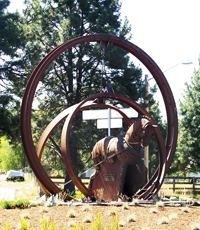Central Oregon is an eclectic mix of culture and diversities complete with writers, filmmakers, visual artists, musicians and songwriters, avid sports enthusiasts from golfers to hunters, retirees, college students, scientists, cowboys, software designers and beer makers. Commentary by Pamela Hulse Andrews
Any effort to describe what makes a great town is bound to elicit a multiple of desires. To some a great city has an influx of ethnic cultures, high-end shopping and the presence of jazz clubs, all night restaurants and a happening nightlife. That’s not, however, what you’ll discover in any of the myriad of charming towns that make up the high desert.
 Instead you find original culture mixed with sustainable environments and a desire to keep our communities small but prosperous. The air is clean, the water is top quality, the rivers and mountains are inviting and accessible and the small economies that are growing in various sections of the region are hopeful. The traffic is manageable, roundabouts add pizzazz to our driving experience, restaurants are pretty fabulous, the schools are excellent and where else can you park right in front of Victoria Secret at numerous times of the day?
Instead you find original culture mixed with sustainable environments and a desire to keep our communities small but prosperous. The air is clean, the water is top quality, the rivers and mountains are inviting and accessible and the small economies that are growing in various sections of the region are hopeful. The traffic is manageable, roundabouts add pizzazz to our driving experience, restaurants are pretty fabulous, the schools are excellent and where else can you park right in front of Victoria Secret at numerous times of the day?
The artist community is so bountiful that one often wonders how these artists find a way to make a living here. The answer, of course, is that most can’t survive on art alone, but the desire to live here makes them forge other avenues of revenue. Their commitment to Central Oregon can simply be called a blessing for the rest of us.
The glass is mostly full and only the ambiguity of our occasional muddy politics, lack of elected leadership, infrastructure issues and shortage of funds for all the needs that fill the envelope makes the reality of life in the high desert slightly less secure. If anything makes a difference it is the cream of the crop in savvy land developers, patrons of the arts and culture and contributors to worthy nonprofits that help the less fortunate.
This is an extraordinary place to live and is distinguished not just by our remoteness but our culture, our environment and….our own form of charisma. Thanks for adding your particular charm…and for your commitment to these communities.
Cities are gentrified by the following types of people in sequence: first the risk-oblivious (artists), then the risk-aware (developers), finally the risk adverse (dentists from New Jersey).
—Bill Kraus (Gay rights activist, liaison between the San Francisco gay community and Congress in the 1980s)

